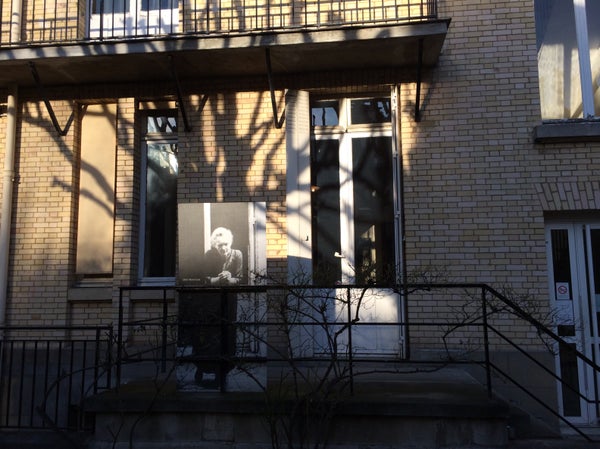本文發表於《大眾科學》的前部落格網路,反映了作者的觀點,不一定反映《大眾科學》的觀點
居里博物館是一個小型的免費博物館,隱藏在巴黎的居里研究所研究園區內。它不是大多數巴黎遊客的首選,但如果您發現自己身處拉丁區,花一個小時左右的時間在這裡參觀會很有趣。
瑪麗·居里一直讓我感到遙不可及。她是第一位兩次獲得諾貝爾獎的科學家,我很難想象她不是一個高高在上的天才,總是弓著腰伏在筆記本或實驗室裝置上,她的思維速度比任何人都快。她是否和我們其他人存在於同一個層面?她應該是一個鼓舞人心的人物,但我一直無法將她視為我可以效仿的人。我怎麼能希望與如此高不可攀的人相提並論呢?
居里夫人和她的遺物實際上是不可觸控的事實,並沒有幫助我感覺與她更親近。她的遺骸具有放射性,因此被安葬在鉛襯棺材中。博物館中的一些檔案是複製品,而不是真品,因為她的許多遺物仍然具有太強的放射性,不能靠近博物館參觀者。佩戴防護服的研究人員可以將它們從法國國家圖書館鉛襯儲藏箱中取出,但他們需要簽署一份棄權書,表明他們意識到風險。
關於支援科學新聞報道
如果您喜歡這篇文章,請考慮透過以下方式支援我們屢獲殊榮的新聞報道 訂閱。透過購買訂閱,您將幫助確保有關塑造我們當今世界的發現和想法的具有影響力的故事的未來。
但我參觀居里博物館的經歷幫助我將瑪麗·居里視為一個真實的人。
居里博物館位於居里夫人本人在 1914 年至 1934 年工作的實驗室中。它展出了 1920 年代和 1930 年代的鐳熱潮、居里家族及其工作,以及後來的鐳研究所(現在的居里研究所)所做的工作。參觀者可以窺視居里夫人的舊辦公室,想象居里夫人本人在那裡主持工作。在建築物外,一張真人大小的居里夫人照片靠在欄杆上,望著她的花園,沉思著放射性的秘密。這張照片似乎正是在它現在展示的同一地點拍攝的,過去的一瞥就站在現在。很容易想象居里夫人花了大量時間倚靠在那欄杆上,陷入沉思。
但我在其中一個展示櫃中發現的一封信,比她凝視花園的沉思午後照片更讓我覺得她人性化。
“我們必須解決一個與實驗用交流電(照明和動力)供應有關的小困難”,信中開頭寫道。當我讀到它時,我忍不住笑了。瑪麗·居里也和我們一樣!在她完成工作之前,她也必須處理行政和後勤上的麻煩事!
不幸的是,我不知道這封信是寫給誰的,也不知道她試圖解決的確切性質是什麼。從我所能判斷的來看,她試圖在進行實驗的房間裡正確設定交流電,但我不知道她試圖克服的具體後勤障礙是什麼。無論如何,這封信讓我可以想象瑪麗·居里,這位傑出的天才,她實驗室的女皇,在做著 1924 年相當於傳送技術支援電子郵件的事情,以將實驗室電腦連線到大學網路。
您可以在下面閱讀這封信的全文和我翻譯的版本。
Cher ami,
Nous avons à résoudre une petite difficulté relative à la fourniture du courant alternatif (éclairage et force) au service des manipulations. J’avais espéré que chacun de nous pourrait avoir ses propres lignes commandées par un transformateur placé dans sa propre cabine, avec connexions facultatives. Ainsi on aurait évité toute comptabilité et toute difficulté de surveillance. Mais il parait que nous ne pouvons être autorisés à poser ce double système de lignes et que par suite nous ne pourrons pas avoir faire dépendre les lignes du service de manipulations comme toutes les autres lignes de notre annexe, d’un transformateur de haute tension placé dans notre cabine. Cela nécessiterait, d’une part, un accord sur votre participation aux frais de fourniture de courant alternatif, d’autre part un accord de principe sur le service et les responsabilités. Il est, en effet, absolument nécessaire que nous dehors des heures de service et pendant les jours de vacances. Ceci ne présenterait pas de difficulté si, comme je le suppose, vous n’utillesez le local que pour vos manipulation a l’époque où vous en disposerez, il y aurait de ce coté une difficulté que vous pourriez résoudre le mieux, je crois, en vous servant de lignes volantes venant de votre laboratoire.
Il importe que nous soyons d’accord sur cette question avant de prendre une décision définitive relativement à l’alimentation en courant alternatif et je vous serais très obligée de me dire votre opinion.
Avec mes meilleures amitiés.
In English
Dear friend,
We have to solve a small difficulty relative to the supply of the alternating current (lighting and force) for the experiments. I had hoped that each of us could have their own lines controlled by a transformer placed in their own cubicle, with optional connections. This would have prevented any accounting and any monitoring difficulties. But it seems that we cannot be allowed to lay down this double system of lines, and that consequently we cannot have the experiment service lines, like all the other lines of our annex, on a high voltage transformer placed in our cubicle. This would require, on the one hand, an agreement on your participation in the cost of supplying AC power, and on the other hand an agreement in principle on electrical service and responsibilities. It is, indeed, absolutely necessary for us to use it outside of business hours and during the holidays. This would not be difficult if, as I suppose, you use the premises only for your experiments at the time you have at your disposal, there would be a difficulty that you could solve best, I think, Using flying lines from your laboratory.
It is important that we agree on this issue before making a final decision on AC power, and I would be very grateful if you could give me your opinion.
All the best.
